How Many Deck Blocks Do You Need?
If you’re using deck blocks then an important first step when creating your list of materials is to work out exactly how many you need for your project.

Before we delve into any specifics, let’s first cover the main factors that affect our calculations:
- What are the dimensions of your project?
- What size lumber are you using?
- What are your joist centres?
- Which direction are your cross joists?
- Is your project raised or is it a ground level deck?
1. The dimensions of your project
This one is pretty self-explanatory, but some decks may have multiple corners or curved edges which affects the number of deck blocks required.
2. What size lumber are you using?
The size of lumber will determine what your spans will be. The thicker your lumber, the further apart your span supports can be. It’s generally recommended that 140mm or thicker be used for a sturdy deck. Check your local span tables to find out what is required by code.
3. What are your joist centres?
The spacing of the joists will depend on the type and thickness of the deck board material you are using, as well as the design and load requirements of the deck. In general, joists for a deck should be spaced 450mm on center for rectangular decks and 300mm on center for diagonal decks. However, it is always best to consult the specific installation instructions for the decking material you are using to ensure that the joists are spaced correctly.
In general, composite boards require closer joist centres (to remove ‘bounce’), whereas hardwood boards can be further apart.
Additionally, local building codes may have specific requirements for the spacing of deck joists, so it is important to check with your local building department to ensure that your deck is built in compliance with all applicable codes.
4. Which direction are your cross joists?
As you’ll see in examples below, the direction of your cross joists can have a significant impact on the number of deck blocks you’ll require. For example, with a 3m x 6m deck, the number of supports can vary from 32 to 54 depending on whether the joists are along the 6m length or the 3m length.
5. Is your project raised or is it a ground level deck?
If you’re building a raised deck with a layer of bearers beneath your joists then you’ll require fewer deck blocks. For a visual explanation of this, check out our 3D explainer video showing this in action:
https://www.youtube.com/watch?v=oT9bLQWw5vw&t=110s
A ground level deck is often the preferred choice for floating decks because it removes the step up and allows you to walk straight onto it much like a patio or walkway. If you do build a raised deck, then it cuts the number of deck blocks needed by roughly 40-60%.
Lastly let’s cover span tables in more detail.
Span tables for lumber are tables that provide information on the maximum allowable span of lumber for a given size, species, and grade of lumber when used in various types of construction. Span tables are used by builders and contractors to determine the size and spacing of the lumber members required to support a given load. The tables take into account the strength and stiffness of the lumber, as well as other factors such as moisture content, type of load, and duration of the load. Span tables are typically provided by lumber manufacturers and can also be found in building codes and design guides.
Span tables also gives us an indication of allowed overhang for our joists. An overhang isn’t required, but it’s useful to hide the TuffBlocks under the deck. A typical allowed overhang is ¼ to 1/3 of your span table for the lumber you’re using. It’s always best to check your local building codes to see what is allowed in your area.
Now that we’ve covered off the main factors, let’s dive into some practical examples.
N.b: Each deck includes an overhang with an additional cross joist in order to hide the TuffBlocks. In practice this will need to be bridged to provide support.
Example 01: A 3m x 6m ground level deck using composite decking boards & 2x6 treated southern pine joists
In this example our cross joists will be along the 6m length.
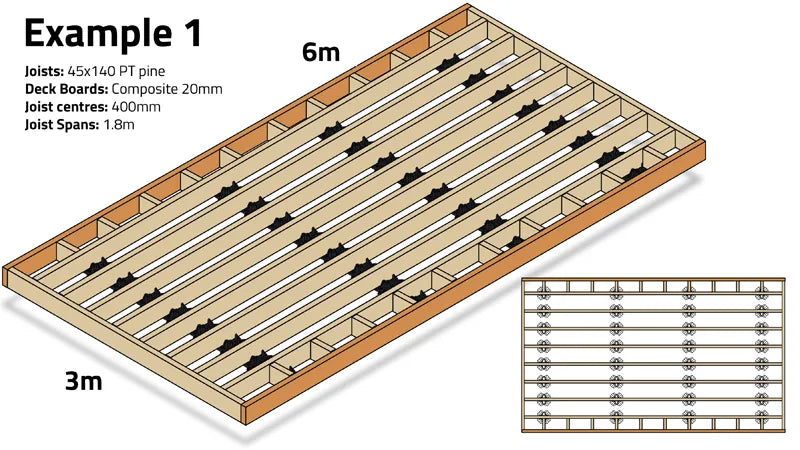
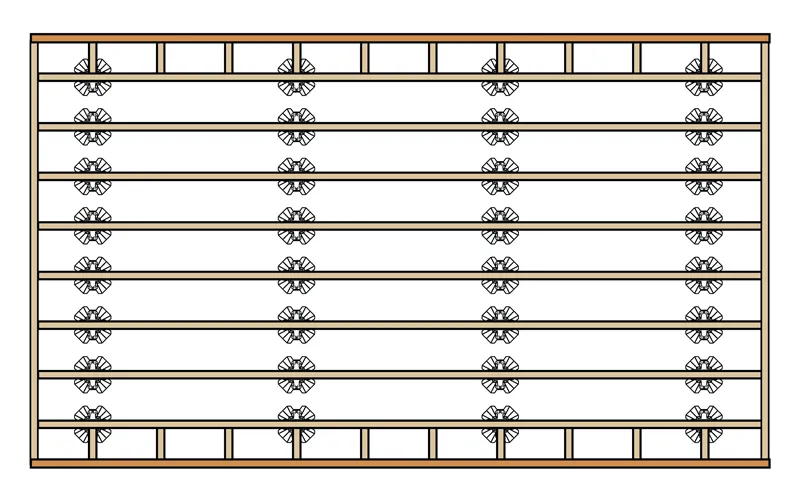
There are many different materials that can be used for decking boards, including wood, composite materials, and plastic. Wood decking boards are commonly made from lumber species such as cedar, redwood, or pressure-treated pine. Composite decking boards are made from a mixture of wood fibers and plastic, and are a popular alternative to wood because they are more durable and require less maintenance.
They do tend to have more flex than cedar or redwood, so the joist centres need to be closer together (400mm in this case) to remove any ‘bounce’ from the deck and to make sure it’s firm under foot.
Check with the supplier as they will be able to guide you on the appropriate joist centres for your specific deck boards.
Therefore, we’ll require 8 cross joists at 400mm centres.
The allowable span for 140mm x 45mm pine is 2.5m. Although this is the ‘allowable’ span, in practice it’s much more common with 140mm x 45mm is to use a 1.5m span for a firm and durable deck without any bowing of the joists or sag over time.
Therefore, we’ll require 4 TuffBlocks per 6m joist, spaced 1.5m apart with a 300mm overhang on the ends.
8 joists x 4 supports = 32 TuffBlocks
Example 02
Now let’s change the direction of the cross joists, so they’re aligned with the 3m length.
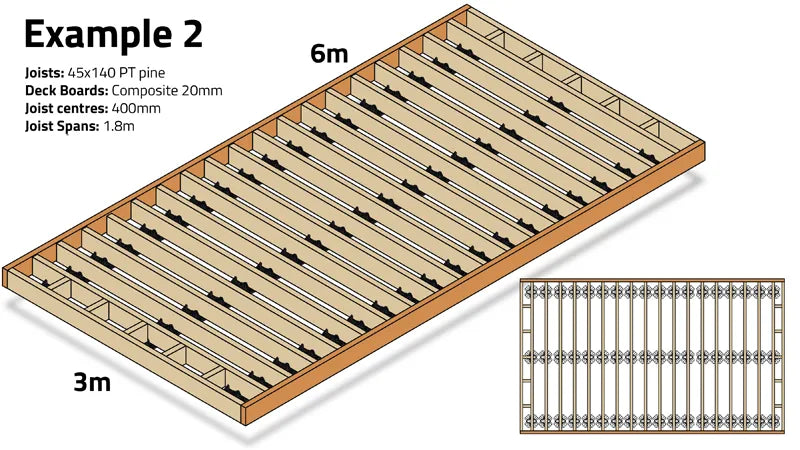
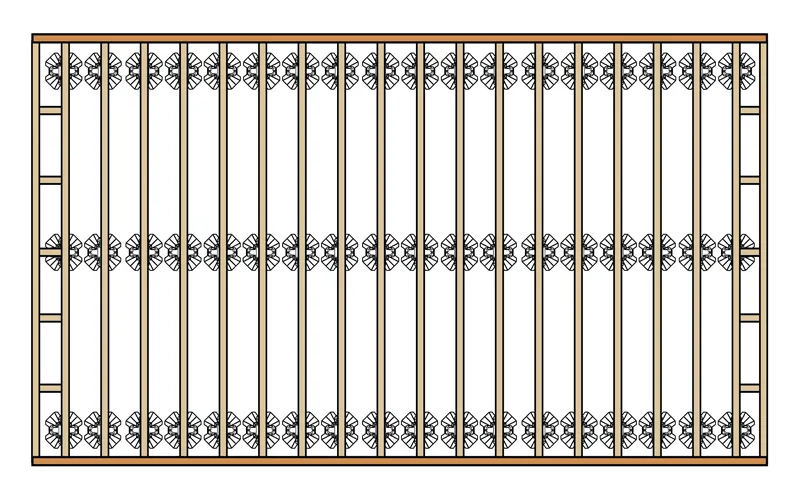
The direction of your cross joists is determined by the direction of the deck boards (which will be the opposite direction). Typically you want to face the deck boards parallel to the direction you’ll be walking onto the deck in order to have the most grip under foot. But this is also mostly to taste.
We require 18 cross joists at 14 inch centres.
Each cross joist requires 3 deck blocks.
18 joists x 3 supports = 54 TuffBlocks
Example 03
With 45mm x 240mm joists we could eliminate the middle supports, with only 2 TuffBlocks per cross joist:
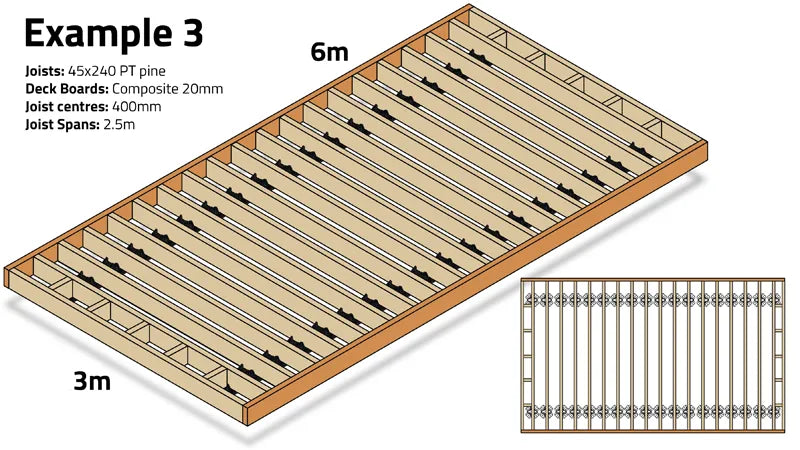
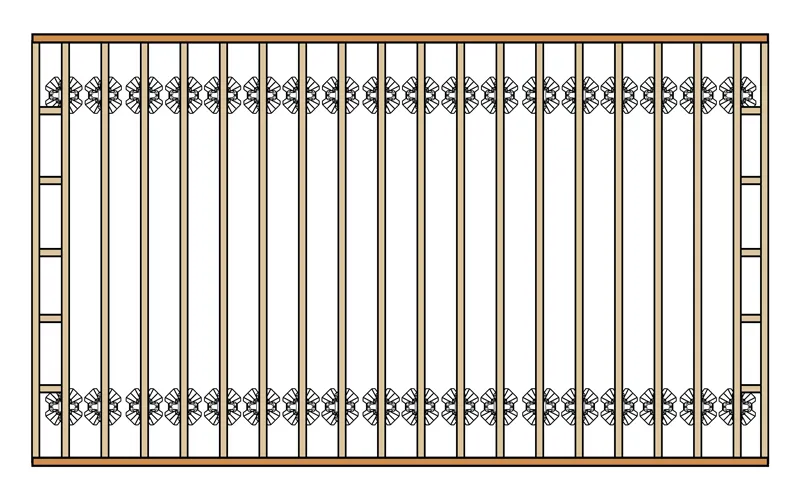
This would raise the deck by 100mm, but it would reduce the number of TuffBlocks down to 36 (18 x 2).
We’d definitely recommend a middle support in this instance for the longevity of your deck and to make sure it’s sturdy, but this is to illustrate that using thicker joists could impact the number of deck blocks you’d require.
Example 04
Let’s look at another example here but instead of composite boards, let’s use a hardwood deck board. We’ll also replace the 140mm joists with 240mm.
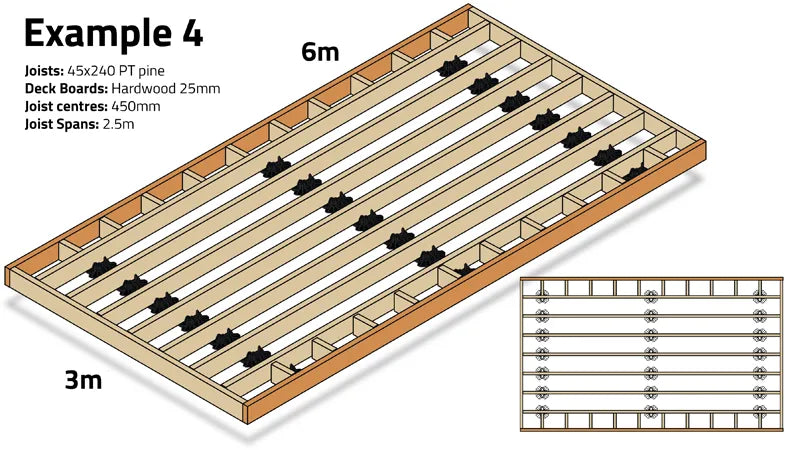
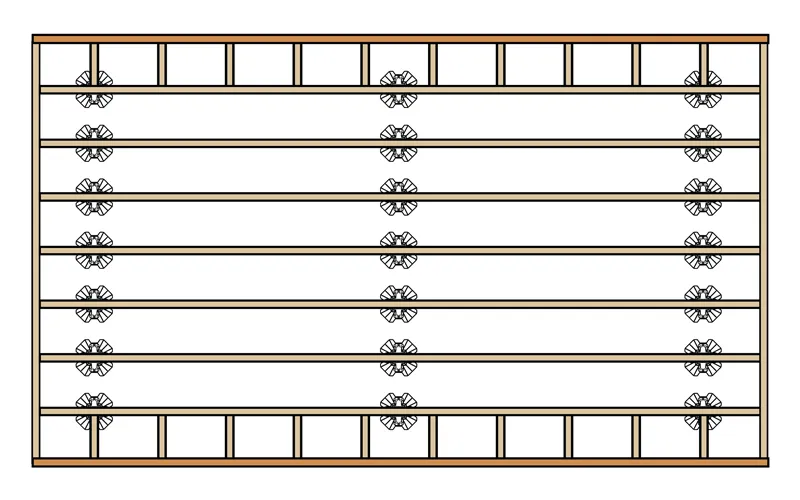
This deck has 7 cross joists at 450mm centres.
And with the 240mm joists, we have 2.5m spans with a 600mm overhang on either side.
7 joists x 3 supports = 21 TuffBlocks.
Example 05
The final example demonstrates a raised deck (although hard to illustrate from a top down) that uses bearers beneath joists:

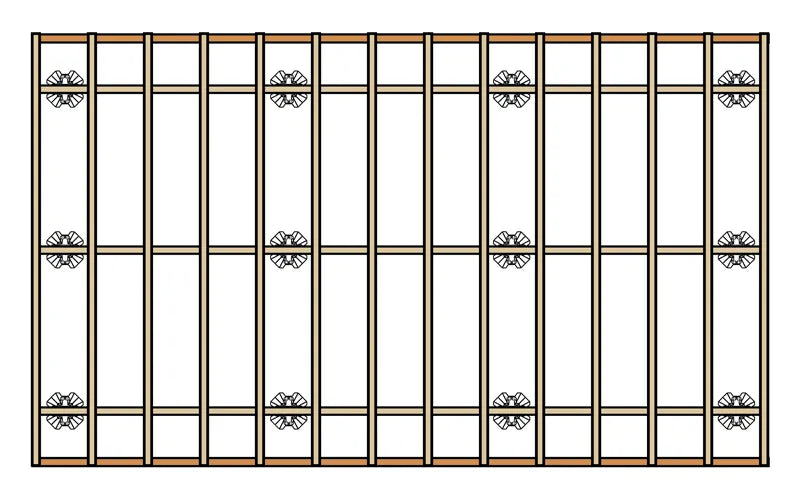
The bearers use 4 supports per bearer and are spaced (slightly under) 1.5m apart.
This allows the joists to be supported at 1.5m spans.
The joists are spaced 450mm apart, on which the decking boards will be placed.
So for our calculations:
3 bearers x 4 supports = 12 TuffBlocks.
By using a row of bearers beneath our joists, we reduce the number of TuffBlocks required from 32 down to 12.
Conclusion:
With these 5 examples, we can see how a number of factors can affect the number of deck blocks our floating deck requires:
Deck 01: 32 TuffBlocks
Deck 02: 54 TuffBlocks
Deck 03: 36 TuffBlocks
Deck 04: 21 TuffBlocks
Deck 05: 12 TuffBlocks
Please bear in mind that you will need to build in line with your local codes that govern span tables and joist centres for the lumber that you’re using.
Additionally, some builders like to use more supports to ensure the strength, sturdyness and longevity of their deck. The more deck blocks used along the spans, the firmer the deck will feel.
Likewise, the closer the joist centres, the firmer the deck boards will feel under foot.





Leave a comment